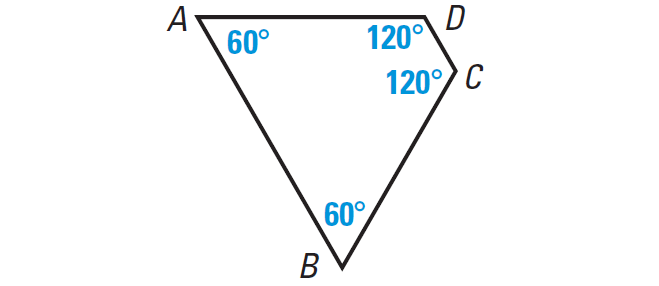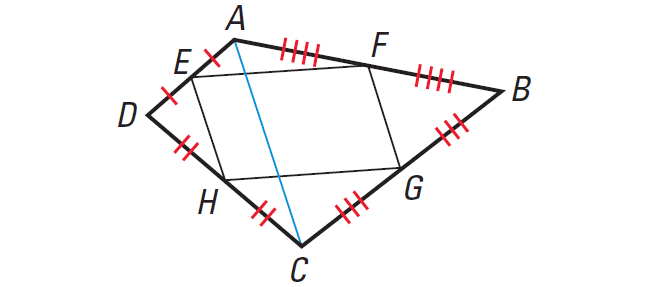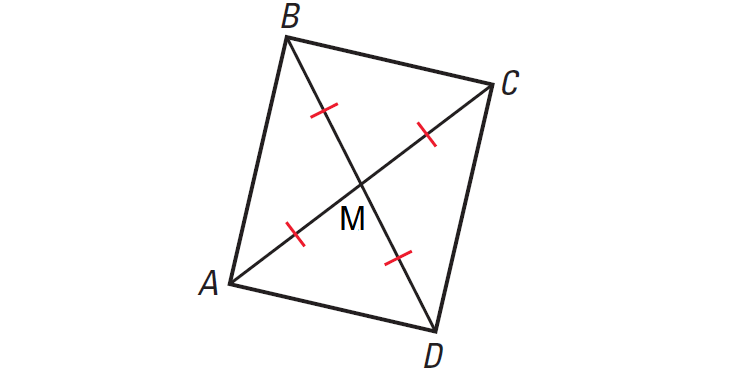SPECIAL QUADRILATERALS WORKSHEET
Subscribe to our ▶️ YouTube channel 🔴 for the latest videos, updates, and tips.
1. "A quadrilateral has at least one pair of opposite sides congruent". What type of special quadrilateral can meet the above condition?
2. When we join the midpoints of the sides of any quadrilateral, what type of special quadrilateral formed ? Explain your answer.
3. What type of quadrilateral is ABCD shown below?

4. The diagonals of the quadrilateral ABCD intersect at point M to produce four congruent segments AM, BM, CM and DM. What type of quadrilateral is ABCD ? Prove that your answer is correct.

1. Answer :
There are many possibilities.
Parallelogram :
Opposite sides are congruent.
Rhombus :
All sides are congruent.
Rectangle :
Opposite sides are congruent.
Square :
All sides are congruent.
Isosceles Trapezoid :
Legs are congruent.
2. Answer :
Let E, F, G and H be the midpoints of the sides of the quadrilateral ABCD shown below.

If we draw AC, the Midsegment Theorem for Triangles says
FG || AC and EH || AC ----> FG || EH
Similar reasoning shows that
EF || HG
So, by definition, EFGH is a parallelogram.
Hence, when the midpoints of the sides of any quadrilateral are joined, the type of special quadrilateral formed is parallelogram.
3. Answer :

In the quadrilateral ABCD shown above, A and ∠D are supplementary, but m∠A and m∠B are not.
So, AB is parallel to DC, but AD is not parallel to BC.
By definition, ABCD is a trapezoid.
Because base angles are congruent, ABCD is an isosceles trapezoid.
4. Answer :
Draw a diagram :
Draw the diagonals as described. Then connect the endpoints to draw quadrilateral ABCD.

Make a conjecture :
Quadrilateral ABCD looks like a rectangle.
Given :
AM ≅ BM ≅ CM ≅ DM
To prove :
ABCD is a rectangle.
Paragraph proof :
Because we are given information about the diagonals, let us show that ABCD is a parallelogram with congruent diagonals.
First prove that ABCD is a parallelogram.
Because BM ≅ DM and AM ≅ CM, BD and AC bisect each other. Because the diagonals of ABCD bisect each other, ABCD is a parallelogram.
Now, prove that the diagonals of ABCD are congruent.
From the given information, we can write
BM = AM
DM = CM
So, by the Addition Property of Equality,
BM + DM = AM + CM
By the Segment Addition Postulate,
BD = BM + DM
AC = AM + CM
So, by substitution,
BD = AC
So, we have
BD ≅ AC
ABCD is a parallelogram with congruent diagonals.
Hence, ABCD is a rectangle.
Subscribe to our ▶️ YouTube channel 🔴 for the latest videos, updates, and tips.
Kindly mail your feedback to v4formath@gmail.com
We always appreciate your feedback.
About Us | Contact Us | Privacy Policy
©All rights reserved. onlinemath4all.com

Recent Articles
-
90 Degree Clockwise Rotation
Jan 01, 26 06:58 AM
90 Degree Clockwise Rotation - Rule - Examples with step by step explanation -
US Common Core K-12 Curriculum Algebra Solving Systems of Equations
Jan 01, 26 04:51 AM
US Common Core K-12 Curriculum - Algebra : Solving Systems of Linear Equations -
Solving the HARDEST SAT Math Questions ONLY using Desmos
Dec 31, 25 05:53 AM
Solving the HARDEST SAT Math Questions ONLY using Desmos
